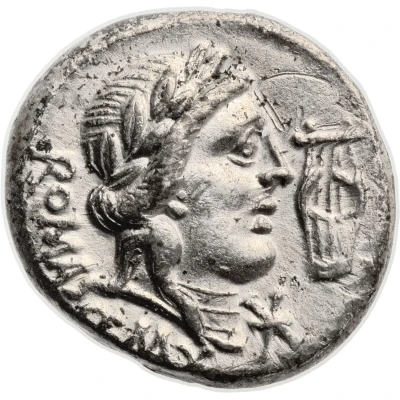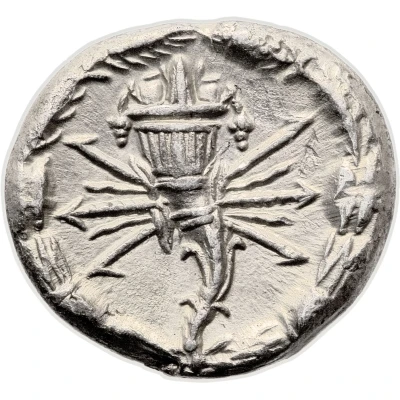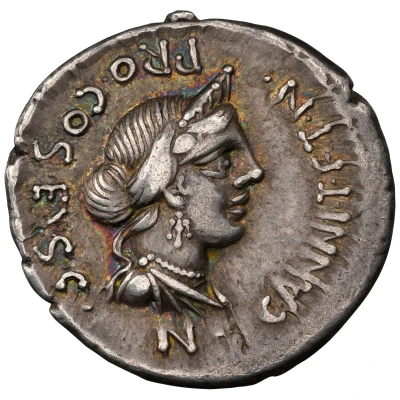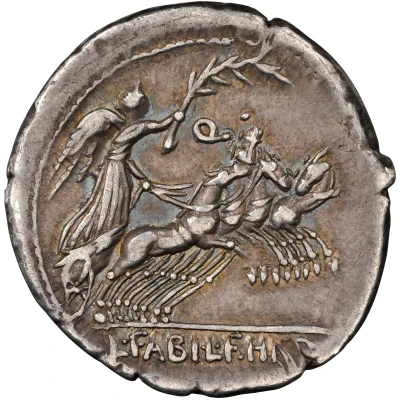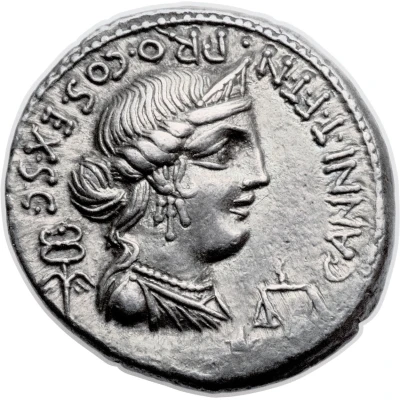
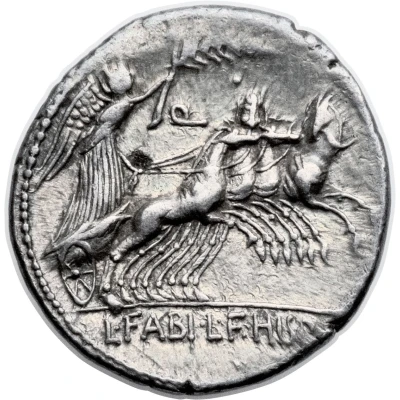

© Heritage Auctions
Denarius Annia: Gaius Annius Luscus; C•ANNI•T•F•T•N•PRO•COS•EX•S•C / L•FABI•L•F•HISP 82 BC - 81 BC
| Silver | 3.72 g | 21 mm |
| Issuer | Rome › Roman Republic (509 BC - 27 BC) |
|---|---|
| Period | Republic (509 BC - 27 BC) |
| Type | Standard circulation coin |
| Years | 82 BC - 81 BC |
| Value | Denarius (1) |
| Currency | Denarius of 16 Asses (141 – 27 BC) |
| Composition | Silver |
| Weight | 3.72 g |
| Diameter | 21 mm |
| Shape | Round (irregular) |
| Technique | Hammered |
| Orientation | Variable alignment ↺ |
| Demonetized | Yes |
| Updated | 2024-10-06 |
| Numista | N#66893 |
|---|---|
| Rarity index | 92% |
Reverse
Winged Victory in quadriga galloping right, holding reins in left hand and palm in right hand raised; above, letter Q.
Second moneyer mark in exergue; sometimes, control-letter above.
Script: Latin
Lettering:
Q
L•FABI•L•F•HISP
Unabridged legend: Lucius Fabius Lucius Filius Hispaniensis
Translation: Lucius Fabius Hispaniensis, son of Lucius
Comment
The gens Annia was a plebeian family at Rome. The first person of this name whom Titus Livius mentions is the Latin praetor Lucius Annius of Setia, a Roman colony in 340 BC. By the time of the Second Punic War, the Annii were obtaining minor magistracies at Rome, and in 153 BC, Titus Annius Luscus attained the consulship. The gens remained prominent at Rome through the first century.The gens Fabia was one of the most ancient patrician families at Rome, playing a prominent part in history soon after the establishment of the Republic. Three brothers are said to have been invested with seven successive consulships, from 485 to 479 BC. The house derived its greatest lustre from the patriotic courage and tragic fate of the 306 Fabii in the Battle of the Cremera in 477 BC. The Fabii were not distinguished as warriors only; several members of the gens were also important in the history of Roman literature and the arts.
Interesting fact
One interesting fact about this coin is that it features a rare and unique design, with the portrait of Gaius Annius Luscus on one side and a jug and lituus on the other. The jug and lituus are symbols of the Roman state and are often depicted on coins during this time period, but the inclusion of Luscus' portrait on the coin makes it stand out from other coins of the same era. Additionally, the coin's silver content and weight of 3.72g make it a valuable and sought-after collector's item among numismatists.
Price
| Date | Mintage | VG | F | VF | XF | AU | UNC |
|---|---|---|---|---|---|---|---|
| ND (82 BC - 81 BC) | - | - | - | - | - | - |
Values in the table are based on evaluations by sales realized on Internet platforms. They serve as an indication only for Denarius (Annia: Gaius Annius Luscus; C•ANNI•T•F•T•N•PRO•COS•EX•S•C / L•FABI•L•F•HISP) (82 BC - 81 BC) coin.
